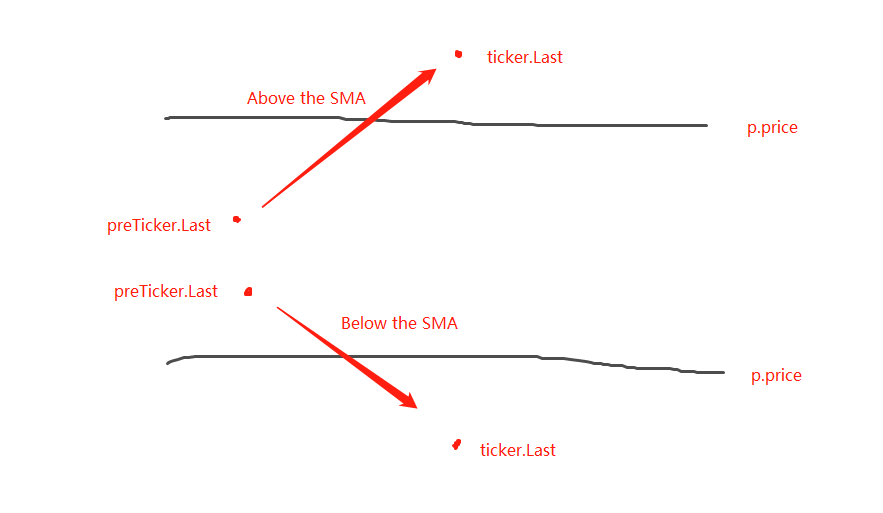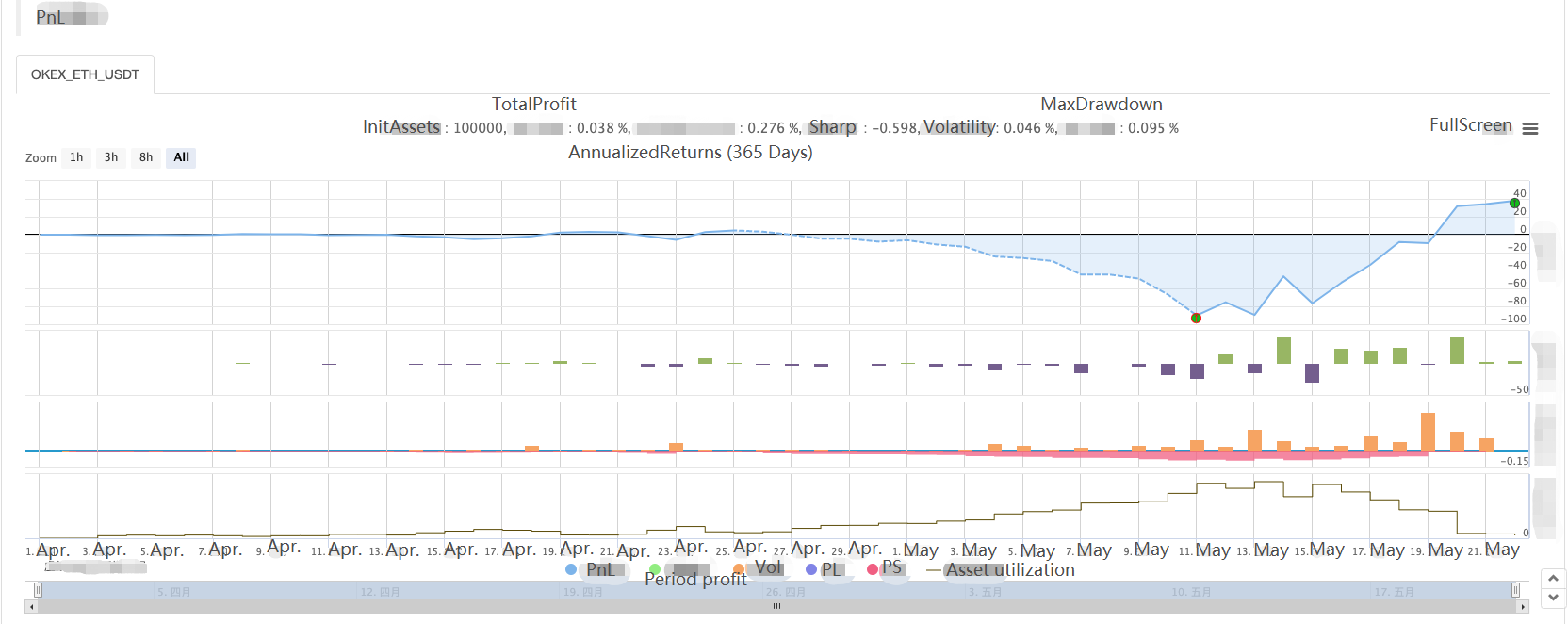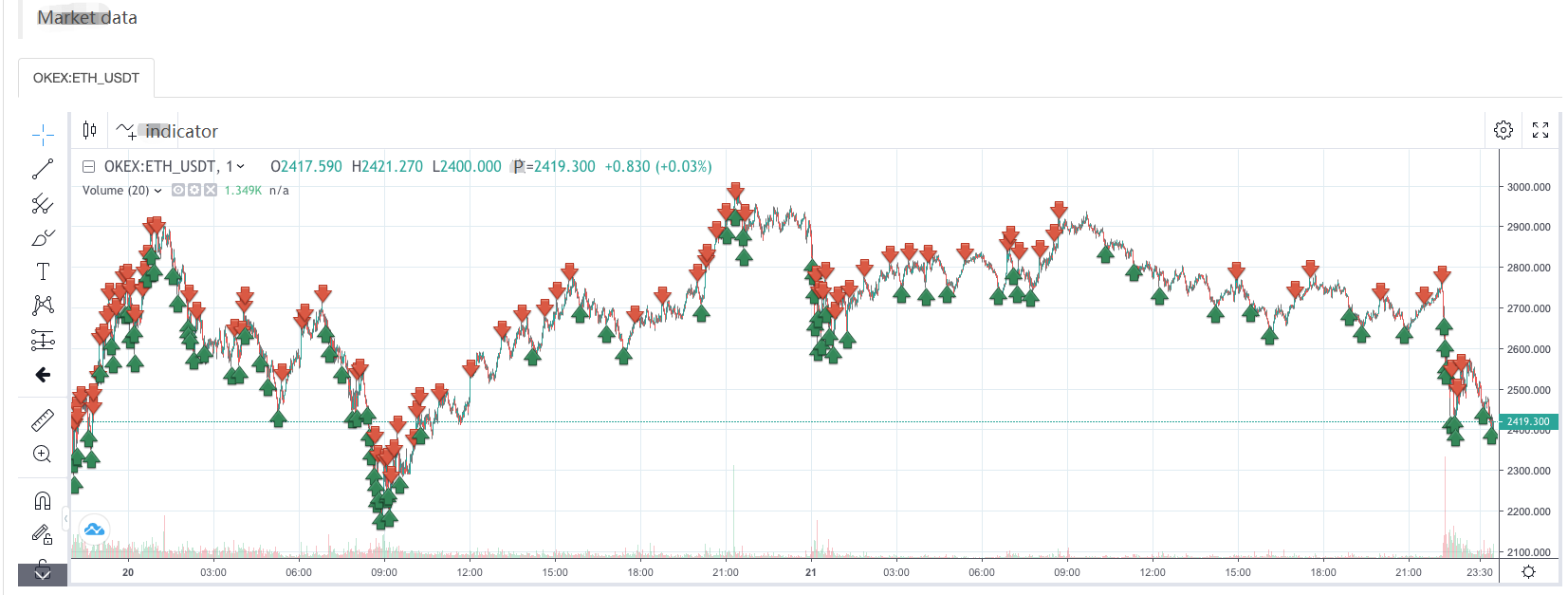शुरुआती के लिए क्रिप्टोकरेंसी मात्रात्मक व्यापार - आपको क्रिप्टोकरेंसी मात्रात्मक के करीब ले जाना (5)
लेखक:FMZ~Lydia, बनाया गयाः 2022-08-03 16:08:50, अद्यतन किया गयाः 2023-09-21 21:07:02
पिछले लेख में, हमने एक सरल ग्रिड रणनीति के व्यापार तर्क विश्लेषण की व्याख्या की। इस लेख में, हम इस ट्यूटोरियल रणनीति के डिजाइन को पूरा करना जारी रखेंगे।
-
व्यापारिक तर्क विश्लेषण जैसा कि हमने पिछले लेख में उल्लेख किया है, आप प्रत्येक ग्रिड लाइन को पार करके और वर्तमान मूल्य क्रॉसिंग को ऊपर या नीचे आंका जाकर एक व्यापार कार्रवाई को ट्रिगर कर सकते हैं। लेकिन वास्तव में, अभी भी बहुत सारे तर्क विवरण हैं, और शुरुआती जो रणनीति लेखन को नहीं समझते हैं वे अक्सर गलतफहमी पैदा करते हैं कि तर्क बहुत सरल है, कोड में केवल कुछ पंक्तियां होनी चाहिए, लेकिन अभी भी वास्तविक लेखन में बहुत सारे विवरण पाए जाते हैं।
पहला विवरण हम पर विचार करना है अनंत ग्रिड के डिजाइन है. क्या आपको याद है कि हम एक समारोह डिजाइन किया है
createNetपिछले लेख में एक साथ प्रारंभिक ग्रिड डेटा संरचना उत्पन्न करने के लिए? यह फ़ंक्शन ग्रिड डेटा संरचना को ग्रिड लाइनों की एक परिमित संख्या के साथ उत्पन्न करता है। तो क्या होगा यदि रणनीति चल रही है जब कीमत इस ग्रिड डेटा संरचना की सीमाओं से परे जाती है (ऊपरी ग्रिड लाइन से परे जहां कीमत सबसे अधिक है, और निचली ग्रिड लाइन जहां कीमत सबसे कम है)? तो हमें पहले ग्रिड डेटा संरचना में एक विस्तार तंत्र जोड़ने की जरूरत है।चलो रणनीति मुख्य समारोह लिखने के लिए शुरू करते हैं, जो कोड है जहां रणनीति निष्पादन शुरू होता है
var diff = 50 // Global variables and grid spacing can be designed as parameters for easy explanation. We write this parameter into the code. function main() { // After the real bot starts running, execute the strategy code from here var ticker = _C(exchange.GetTicker) // To get the latest market data ticker, please refer to the FMZ API documentation for the structure of the ticker data: https://www.fmz.com/api#ticker var net = createNet(ticker.Last, diff) // The function we designed in the previous article to construct the grid data structure initially, here we construct a grid data structure net while (true) { // Then the program logic enters this while infinite loop, and the strategy execution will continue to execute the code within the {} symbol here. ticker = _C(exchange.GetTicker) // The first line of the infinite loop code section, get the latest market data and update it to the ticker variable // Check the grid range while (ticker.Last >= net[net.length - 1].price) { net.push({ buy : false, sell : false, price : net[net.length - 1].price + diff, }) } while (ticker.Last <= net[0].price) { var price = net[0].price - diff if (price <= 0) { break } net.unshift({ buy : false, sell : false, price : price, }) } // There are other codes... } }ग्रिड डेटा संरचना को विस्तार योग्य बनाने के लिए यह कोड है (ऊपर दिए गए कोड से निकाला गया):
// Check the grid range while (ticker.Last >= net[net.length - 1].price) { // If the price exceeds the grid line of the highest price of the grid net.push({ // Just add a new grid line after the grid line with the highest price of the grid buy : false, // Initialize sell marker sell : false, // Initialize buy marker price : net[net.length - 1].price + diff, // dd a grid spacing to the previous highest price }) } while (ticker.Last <= net[0].price) { // If the price is lower than the grid line of the lowest price of the grid var price = net[0].price - diff // Different from adding upwards, it should be noted that the price of adding new grid lines downwards cannot be less than or equal to 0, so it is necessary to judge here if (price <= 0) { // Less than or equal to 0 will not be added, jump out of this loop break } net.unshift({ // Add a new grid line just before the grid line with the lowest price of the grid buy : false, sell : false, price : price, }) }अगला कदम यह विचार करना है कि ट्रेडिंग ट्रिगर को विशेष रूप से कैसे लागू किया जाए।
var diff = 50 var amount = 0.002 // Add a global variable, which can also be designed as a parameter. Of course, for the sake of simplicity, we also write it in the strategy code. // This parameter controls the trade volume each time a trade is triggered on the grid line function main() { var ticker = _C(exchange.GetTicker) var net = createNet(ticker.Last, diff) var preTicker = ticker // Before the main loop (fixed loop) starts, set a variable to record the last market data while (true) { ticker = _C(exchange.GetTicker) // Check the grid range while (ticker.Last >= net[net.length - 1].price) { net.push({ buy : false, sell : false, price : net[net.length - 1].price + diff, }) } while (ticker.Last <= net[0].price) { var price = net[0].price - diff if (price <= 0) { break } net.unshift({ buy : false, sell : false, price : price, }) } // Retrieve grid for (var i = 0 ; i < net.length ; i++) { // Iterate over all grid lines in the grid data structure var p = net[i] if (preTicker.Last < p.price && ticker.Last > p.price) { // Above the SMA, sell, the current node has already traded, regardless of SELL BUY, it will no longer be traded if (i != 0) { var downP = net[i - 1] if (downP.buy) { exchange.Sell(-1, amount, ticker) downP.buy = false p.sell = false continue } } if (!p.sell && !p.buy) { exchange.Sell(-1, amount, ticker) p.sell = true } } else if (preTicker.Last > p.price && ticker.Last < p.price) { // Below the SMA, buy if (i != net.length - 1) { var upP = net[i + 1] if (upP.sell) { exchange.Buy(-1, amount * ticker.Last, ticker) upP.sell = false p.buy = false continue } } if (!p.buy && !p.sell) { exchange.Buy(-1, amount * ticker.Last, ticker) p.buy = true } } } preTicker = ticker // Record the current market data in preTicker, and in the next cycle, use it as a comparison between the "previous" market data and the latest one to judge whether to be above the SMA or below the SMA. Sleep(500) } }यह देखा जा सकता है कि:
- ग्रिड लाइनों के ऊपर पार करने की शर्तः
preTicker.Last < p.price && ticker.Last > p.price - ग्रिड रेखाओं के नीचे पार करने की शर्तः
preTicker.Last > p.price && ticker.Last < p.price
यह वही है जो हमने पिछली पोस्ट में कहा था:
- ग्रिड लाइनों के ऊपर पार करने की शर्तः

एसएमए से ऊपर या नीचे होना या नहीं यह निर्णय लेना केवल यह निर्णय लेने का पहला कदम है कि कोई ऑर्डर दिया जा सकता है या नहीं, और ग्रिड लाइन डेटा में निशानों का भी न्याय करना आवश्यक है।
यदि यह एसएमए से ऊपर है, तो यह माना जाता है कि कीमत वर्तमान ग्रिड लाइन और निकटतम ग्रिड लाइन पर खरीद चिह्न से कम है। यदि खरीद चिह्न का मूल्य सच है, तो इसका मतलब है कि पिछली ग्रिड लाइन खरीदी गई है, और पिछले खरीद चिह्न को गलत पर रीसेट करें, और वर्तमान ग्रिड लाइन को गलत पर रीसेट करें।
शर्तों का न्याय करने के बाद, यदि कोई ट्रिगर नहीं है, तो न्याय करना जारी रखें। यदि वर्तमान ग्रिड लाइन पर खरीद / बिक्री के निशान दोनों झूठे हैं, तो इसका मतलब है कि वर्तमान ग्रिड लाइन का व्यापार किया जा सकता है। चूंकि यह एसएमए से ऊपर है, इसलिए हम यहां एक बिक्री ऑपरेशन करेंगे। निष्पादन के बाद, वर्तमान ग्रिड लाइन बेचने के निशान को सही चिह्नित करें।
प्रसंस्करण तर्क SMA से नीचे होने के लिए समान है (बाएं शुरुआती के लिए यहाँ के बारे में सोचने के लिए) ।
पूर्ण रणनीति बैकटेस्टिंग
बैकटेस्टिंग के दौरान कुछ डेटा देखने के लिए, एक समारोहshowTblडेटा प्रदर्शित करने के लिए लिखा जाता है।
function showTbl(arr) {
var tbl = {
type : "table",
title : "grid",
cols : ["grid information"],
rows : []
}
var arrReverse = arr.slice(0).reverse()
_.each(arrReverse, function(ele) {
var color = ""
if (ele.buy) {
color = "#FF0000"
} else if (ele.sell) {
color = "#00FF00"
}
tbl.rows.push([JSON.stringify(ele) + color])
})
LogStatus(_D(), "\n`" + JSON.stringify(tbl) + "`", "\n account Information:", exchange.GetAccount())
}
पूर्ण रणनीति कोडः
/*backtest
start: 2021-04-01 22:00:00
end: 2021-05-22 00:00:00
period: 1d
basePeriod: 1m
exchanges: [{"eid":"OKEX","currency":"ETH_USDT","balance":100000}]
*/
var diff = 50
var amount = 0.002
function createNet(begin, diff) {
var oneSideNums = 10
var up = []
var down = []
for (var i = 0 ; i < oneSideNums ; i++) {
var upObj = {
buy : false,
sell : false,
price : begin + diff / 2 + i * diff,
}
up.push(upObj)
var j = (oneSideNums - 1) - i
var downObj = {
buy : false,
sell : false,
price : begin - diff / 2 - j * diff,
}
if (downObj.price <= 0) { // The price cannot be less than or equal to 0
continue
}
down.push(downObj)
}
return down.concat(up)
}
function showTbl(arr) {
var tbl = {
type : "table",
title : "grid",
cols : ["grid Information"],
rows : []
}
var arrReverse = arr.slice(0).reverse()
_.each(arrReverse, function(ele) {
var color = ""
if (ele.buy) {
color = "#FF0000"
} else if (ele.sell) {
color = "#00FF00"
}
tbl.rows.push([JSON.stringify(ele) + color])
})
LogStatus(_D(), "\n`" + JSON.stringify(tbl) + "`", "\n account Information:", exchange.GetAccount())
}
function main() {
var ticker = _C(exchange.GetTicker)
var net = createNet(ticker.Last, diff)
var preTicker = ticker
while (true) {
ticker = _C(exchange.GetTicker)
// Check the grid range
while (ticker.Last >= net[net.length - 1].price) {
net.push({
buy : false,
sell : false,
price : net[net.length - 1].price + diff,
})
}
while (ticker.Last <= net[0].price) {
var price = net[0].price - diff
if (price <= 0) {
break
}
net.unshift({
buy : false,
sell : false,
price : price,
})
}
// Retrieve grid
for (var i = 0 ; i < net.length ; i++) {
var p = net[i]
if (preTicker.Last < p.price && ticker.Last > p.price) { // Being above the SMA, sell, the current node has already traded, regardless of SELL BUY, it will no longer be traded
if (i != 0) {
var downP = net[i - 1]
if (downP.buy) {
exchange.Sell(-1, amount, ticker)
downP.buy = false
p.sell = false
continue
}
}
if (!p.sell && !p.buy) {
exchange.Sell(-1, amount, ticker)
p.sell = true
}
} else if (preTicker.Last > p.price && ticker.Last < p.price) { // Being below the SMA, buy
if (i != net.length - 1) {
var upP = net[i + 1]
if (upP.sell) {
exchange.Buy(-1, amount * ticker.Last, ticker)
upP.sell = false
p.buy = false
continue
}
}
if (!p.buy && !p.sell) {
exchange.Buy(-1, amount * ticker.Last, ticker)
p.buy = true
}
}
}
showTbl(net)
preTicker = ticker
Sleep(500)
}
}
रणनीति बैकटेस्टिंगः



तो हम ग्रिड रणनीति की विशेषताओं को देख सकते हैं, जब एक प्रवृत्ति बाजार है, वहाँ एक बड़ा तैरता नुकसान होगा, और लाभ एक अस्थिर बाजार में उछाल होगा।
इसलिए, ग्रिड रणनीति जोखिम मुक्त नहीं है। स्पॉट रणनीति अभी भी
- डिजिटल मुद्रा में लीड-लैग सूट का परिचय (3)
- क्रिप्टोकरेंसी में लीड-लैग आर्बिट्रेज का परिचय (2)
- डिजिटल मुद्राओं में लीड-लैग सूट का परिचय (2)
- एफएमजेड प्लेटफॉर्म के बाहरी सिग्नल रिसेप्शन पर चर्चाः रणनीति में अंतर्निहित एचटीपी सेवा के साथ सिग्नल प्राप्त करने के लिए एक पूर्ण समाधान
- एफएमजेड प्लेटफॉर्म के लिए बाहरी सिग्नल प्राप्त करने का अन्वेषणः रणनीति अंतर्निहित एचटीटीपी सेवा के लिए सिग्नल प्राप्त करने के लिए पूर्ण समाधान
- क्रिप्टोकरेंसी में लीड-लैग आर्बिट्रेज का परिचय (1)
- डिजिटल मुद्रा में लीड-लैग सूट का परिचय (1)
- एफएमजेड प्लेटफॉर्म के बाहरी सिग्नल रिसेप्शन पर चर्चाः विस्तारित एपीआई बनाम रणनीति अंतर्निहित एचटीटीपी सेवा
- एफएमजेड प्लेटफॉर्म के लिए बाहरी संकेत प्राप्त करने की खोजः विस्तार एपीआई बनाम रणनीति अंतर्निहित एचटीटीपी सेवा
- रैंडम टिकर जनरेटर पर आधारित रणनीति परीक्षण पद्धति पर चर्चा
- यादृच्छिक बाजार जनरेटर पर आधारित रणनीति परीक्षण के तरीकों का पता लगाना
- डिजिटल मुद्रा कारक मॉडल
- सौदे में अपना उद्धारकर्ता बनें
- क्रिप्टोक्यूरेंसी के मैन्युअल वायदा और स्पॉट की हेजिंग रणनीति
- क्रिप्टोकरेंसी स्पॉट हेजिंग रणनीति का डिजाइन (१)
- मंदी के बाजार के निचले स्तर तक पहुंचने के लिए उपयुक्त स्थायी संतुलन रणनीति
- शुरुआती के लिए क्रिप्टोकरेंसी मात्रात्मक व्यापार - आपको क्रिप्टोकरेंसी मात्रात्मक के करीब ले जाना (8)
- शुरुआती के लिए क्रिप्टोकरेंसी मात्रात्मक व्यापार - आपको क्रिप्टोकरेंसी मात्रात्मक के करीब ले जाना (7)
- शुरुआती के लिए क्रिप्टोकरेंसी मात्रात्मक व्यापार - आपको क्रिप्टोकरेंसी मात्रात्मक के करीब ले जाना (6)
- एफएमजेड क्वांट ट्रेडिंग प्लेटफॉर्म के मुख्य इंटरफ़ेस का अवलोकन और वास्तुकला
- क्रिप्टोक्यूरेंसी वायदा के लिए मार्टिंगेल रणनीति डिजाइन
- शुरुआती के लिए क्रिप्टोक्यूरेंसी मात्रात्मक व्यापार - क्रिप्टोक्यूरेंसी मात्रात्मक के करीब ले जाना (4)
- शुरुआती के लिए क्रिप्टोकरेंसी मात्रात्मक व्यापार - आपको क्रिप्टोकरेंसी मात्रात्मक के करीब ले जाना (3)
- शुरुआती के लिए क्रिप्टोकरेंसी मात्रात्मक व्यापार - क्रिप्टोकरेंसी मात्रात्मक के करीब ले जा रहा है (2)
- शुरुआती के लिए क्रिप्टोकरेंसी मात्रात्मक व्यापार - आपको क्रिप्टोकरेंसी मात्रात्मक के करीब ले जाना (1)
- क्रिप्टोकरेंसी स्पॉट हेजिंग रणनीति का डिजाइन (२)
- एफएमजेड पर सामान्य प्रोटोकॉल अनुबंध पहुंच का एक उदाहरण
- बहु-एक्सचेंज स्पॉट स्प्रेड मध्यस्थता रणनीति तर्क साझा करना
- ट्रेडिंग रणनीतियों के निर्माण के लिए विज़ुअलाइज़ेशन मॉड्यूल - गहन
- रणनीति ड्राइंग डिजाइन को आसान बनाने के लिए KLineChart फ़ंक्शन का उपयोग करें
- KlineChart फ़ंक्शन का उपयोग करके नीति चित्रों के डिजाइन को सरल बनाएं